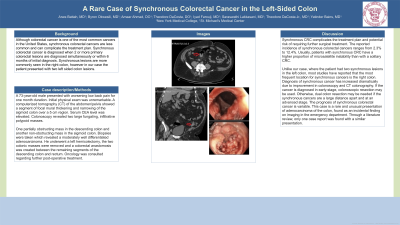Tuesday Poster Session
Category: Colon
P3158 - A Rare Case of Synchronous Colorectal Cancer in the Left-Sided Colon
Tuesday, October 24, 2023
10:30 AM - 4:00 PM PT
Location: Exhibit Hall

Has Audio

Amaar Ahmad, DO
Saint Michael's Medical Center
Newark, NJ
Presenting Author(s)
Arwa Battah, MD1, Byron Okwesili, MD2, Amaar Ahmad, DO1, Theodore DaCosta, DO1, Iyad Farouji, MD1, Saraswathi Lakkasani, MD1, Theodore DaCosta, MD1, Yatinder Bains, MD2
1Saint Michael's Medical Center, Newark, NJ; 2Saint Michael's Medical Center, New York Medical College, Newark, NJ
Introduction: Although colorectal cancer is one of the most common cancers in the United States, synchronous colorectal cancers are less common and can complicate the treatment plan. Synchronous colorectal cancer is diagnosed when 2 or more primary colorectal lesions are diagnosed simultaneously or within 6 months of initial diagnosis. Synchronous lesions are more commonly seen in the right colon, however in our case the patient presented with two left sided colon lesions.
Case Description/Methods: A 73-year-old male presented with worsening low back pain for one month duration. Initial physical exam was unremarkable. A computerized tomography (CT) of the abdomen/pelvis showed a segment of focal mural thickening and narrowing of the sigmoid colon over a 5 cm region. Serum CEA level was elevated. Colonoscopy revealed two large fungating, infiltrative polypoid masses. One partially obstructing mass in the descending colon and another non-obstructing mass in the sigmoid colon. Biopsies were taken which revealed a moderately well differentiated adenocarcinoma. He underwent a left hemicolectomy, the two colonic masses were removed and a colorectal anastomosis was created between the remaining segments of the descending colon and rectum. Oncology was consulted regarding further post-operative treatment.
Discussion: Synchronous CRC complicates the treatment plan and potential risk of requiring further surgical treatment. The reported incidence of synchronous colorectal cancers ranges from 2.3% to 12.4%. Usually, patients with synchronous CRC have a higher proportion of microsatellite instability than with a solitary CRC. Unlike our case, where the patient had two synchronous lesions in the left colon, most studies have reported that the most frequent location for synchronous cancers is the right colon. Diagnosis of synchronous cancer has increased dramatically due to improvement in colonoscopy and CT colonography. If the cancer is diagnosed in early-stage, colonoscopic resection may be used. Otherwise, dual colon resection may be needed if the synchronous cancers are a large distance apart and at an advanced stage. The prognosis of synchronous colorectal cancer is variable. This case is a rare and unusual presentation of adenocarcinoma of the colon, found as an incidental finding on imaging in the emergency department. Through a literature review, only one case report was found with a similar presentation.
Disclosures:
Arwa Battah, MD1, Byron Okwesili, MD2, Amaar Ahmad, DO1, Theodore DaCosta, DO1, Iyad Farouji, MD1, Saraswathi Lakkasani, MD1, Theodore DaCosta, MD1, Yatinder Bains, MD2. P3158 - A Rare Case of Synchronous Colorectal Cancer in the Left-Sided Colon, ACG 2023 Annual Scientific Meeting Abstracts. Vancouver, BC, Canada: American College of Gastroenterology.
1Saint Michael's Medical Center, Newark, NJ; 2Saint Michael's Medical Center, New York Medical College, Newark, NJ
Introduction: Although colorectal cancer is one of the most common cancers in the United States, synchronous colorectal cancers are less common and can complicate the treatment plan. Synchronous colorectal cancer is diagnosed when 2 or more primary colorectal lesions are diagnosed simultaneously or within 6 months of initial diagnosis. Synchronous lesions are more commonly seen in the right colon, however in our case the patient presented with two left sided colon lesions.
Case Description/Methods: A 73-year-old male presented with worsening low back pain for one month duration. Initial physical exam was unremarkable. A computerized tomography (CT) of the abdomen/pelvis showed a segment of focal mural thickening and narrowing of the sigmoid colon over a 5 cm region. Serum CEA level was elevated. Colonoscopy revealed two large fungating, infiltrative polypoid masses. One partially obstructing mass in the descending colon and another non-obstructing mass in the sigmoid colon. Biopsies were taken which revealed a moderately well differentiated adenocarcinoma. He underwent a left hemicolectomy, the two colonic masses were removed and a colorectal anastomosis was created between the remaining segments of the descending colon and rectum. Oncology was consulted regarding further post-operative treatment.
Discussion: Synchronous CRC complicates the treatment plan and potential risk of requiring further surgical treatment. The reported incidence of synchronous colorectal cancers ranges from 2.3% to 12.4%. Usually, patients with synchronous CRC have a higher proportion of microsatellite instability than with a solitary CRC. Unlike our case, where the patient had two synchronous lesions in the left colon, most studies have reported that the most frequent location for synchronous cancers is the right colon. Diagnosis of synchronous cancer has increased dramatically due to improvement in colonoscopy and CT colonography. If the cancer is diagnosed in early-stage, colonoscopic resection may be used. Otherwise, dual colon resection may be needed if the synchronous cancers are a large distance apart and at an advanced stage. The prognosis of synchronous colorectal cancer is variable. This case is a rare and unusual presentation of adenocarcinoma of the colon, found as an incidental finding on imaging in the emergency department. Through a literature review, only one case report was found with a similar presentation.
Disclosures:
Arwa Battah indicated no relevant financial relationships.
Byron Okwesili indicated no relevant financial relationships.
Amaar Ahmad indicated no relevant financial relationships.
Theodore DaCosta indicated no relevant financial relationships.
Iyad Farouji indicated no relevant financial relationships.
Saraswathi Lakkasani indicated no relevant financial relationships.
Theodore DaCosta indicated no relevant financial relationships.
Yatinder Bains indicated no relevant financial relationships.
Arwa Battah, MD1, Byron Okwesili, MD2, Amaar Ahmad, DO1, Theodore DaCosta, DO1, Iyad Farouji, MD1, Saraswathi Lakkasani, MD1, Theodore DaCosta, MD1, Yatinder Bains, MD2. P3158 - A Rare Case of Synchronous Colorectal Cancer in the Left-Sided Colon, ACG 2023 Annual Scientific Meeting Abstracts. Vancouver, BC, Canada: American College of Gastroenterology.
